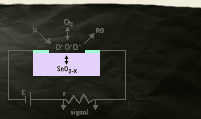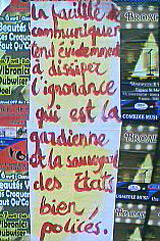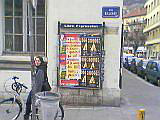 |
 |
  |
|||
| urban posters | ||||
|
_When the context of our life is structured and guided by the logic of neo-liberalism, and mechanisms of control are omnipresent, protest as a pure negation and as an absolute and destructive refusal seems to be no longer efficient, nor productive. Today it is rather in the form silent and almost invisible, it is through a set of banal everyday actions, that resistance takes place and finds its effectiveness. It goes away from destruction towards initiatives to propose alternatives, to reappropriate the space of life, to de-create and create anew. It manifests a will to have a voice and to act in order to manage one’s own environment, in order to be responsible for the space and context we live in. The space of “silent” resistance is the space of our everyday life, far from a world of heroic fantasy. _The space of everyday life is also a public space; it is a space in common. Here a personal intention and initiative meet a collective will and constitute a shared space. _Public space is a space of life in common. It is responsible for the global “ecology” of life and reflects the structure and the mechanisms of contemporary society. As a strategically important place, it is dominated by power structures. It is organized and controlled. The actions are prescribed and supervised (the signs of interdiction of graffiti and non-authorized posters etc.). More immaterial and at the same time the most visible evidence of the characteristic of contemporary society is a gentrification that defines a today’s urban landscape in metropolises and in small towns: |
|||
 |
||||
_New social structure demarcates the city map: life in the city center gets more and more expensive, affluent people replace the poorer population that could hardly afford to keep on living there, and the difference of “styles of life” and of living conditions in the centre and in suburbs is more and more remarkable. Differentiation and «specialization» of areas take place in cities. «Rich» districts and «poor» ones become islands separated by a “style of life”.The territories whose borders are marked by the special «style» of institutions of infrastructure: «their» (high-class or low-class) housing, «their» (high-class or low-class) shops, restaurants, fitness-clubs etc. cultivated by «their» magazines. After all, it seems that the ideal style of life today is everywhere the same, but there are people who can afford it and those who cannot but still have it as an ideal, satisfying themselves with cheap copies of high brands.
_Our project is based on the research of traces of “silent” resistance, and is to define the domains of urban public space where it could take or takes place. The project is based on the observations and is not meant to be illustrative nor didactic, nor to fit the already established forms. It is an intention to look at life around with attentive eyes.
_So, walking in the city and looking around one day, I came across an advertisement of female lingerie with an image of a young woman in bra. Over the image on the glass of the light-box one could remark a phrase «Women are not objects» written with a marker. A feminist slogan over the image of a half-naked woman, sexy and appealing, like it should be in the genre of advertisement, responding to ideals cultivated by the media in contemporary society. Few days later the protesting texts were already printed on paper evoking a form of a sticker, and pasted over the poster, that made me imagine a certain “organization” behind this gesture.
* Serge Daney. Before and After the Image / Documenta X. The Book : Politics Poetics. Ostfildern, 1997. P. 610 E. Y. |
||||
 |

